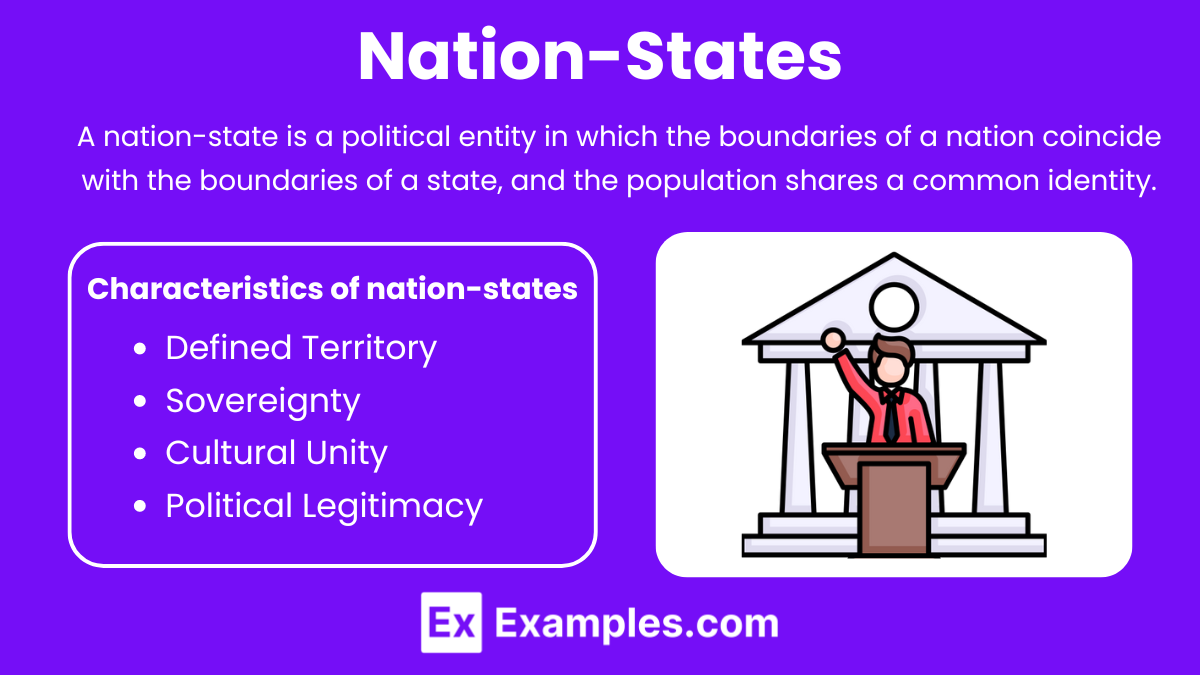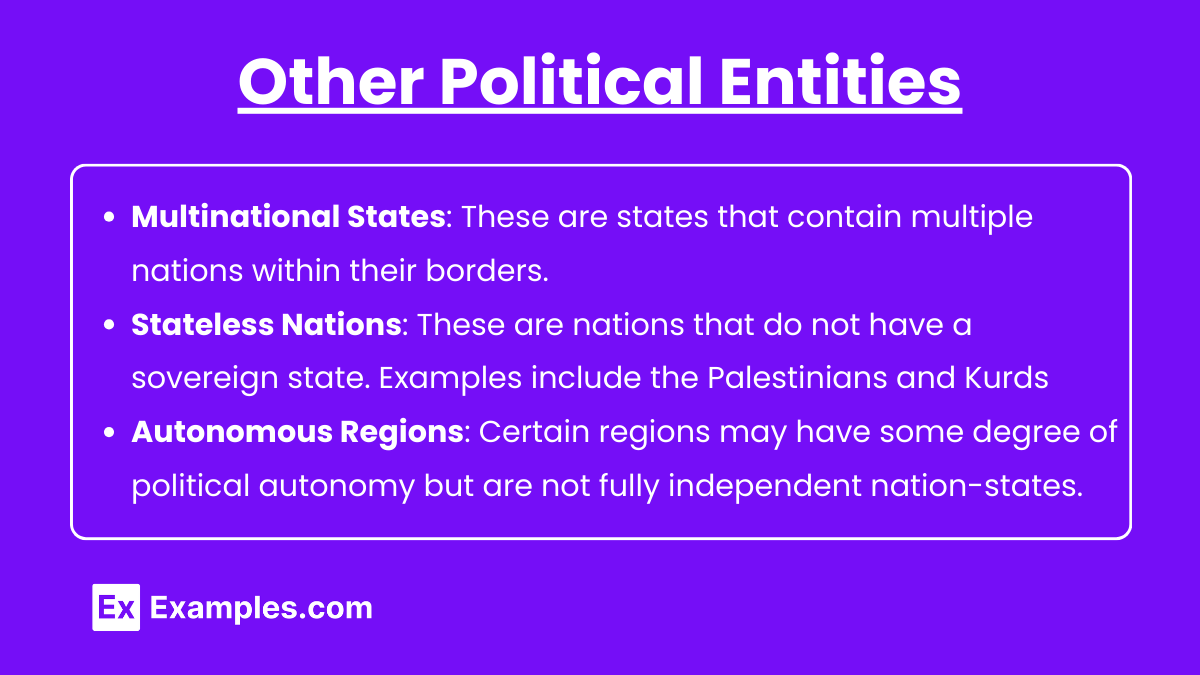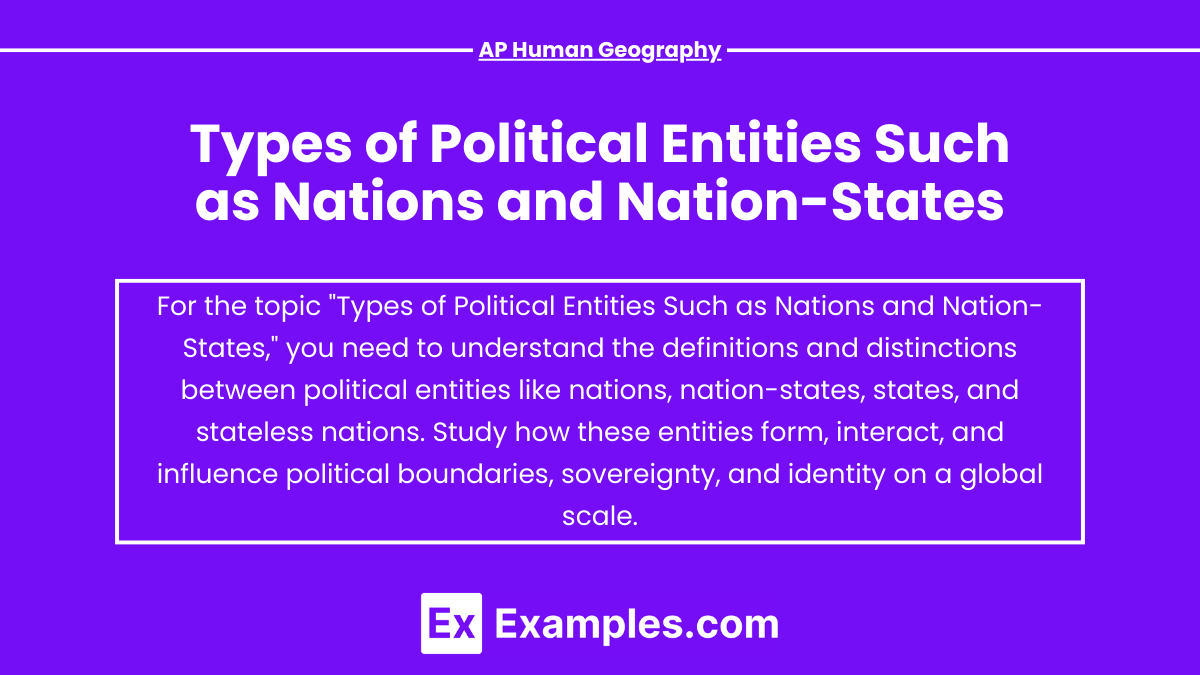In AP Human Geography, political entities such as nations and nation-states are key concepts that help explain how people and territory are organized. A nation refers to a group of people with shared cultural traits, such as language or religion, often without defined political boundaries. A nation-state, on the other hand, is a sovereign state where a single nation predominates, and political boundaries align with the cultural identity of its population. Understanding these entities is critical for analyzing global political organization and territorial conflicts.
Free AP Human Geography Practice Test
Learning Objectives
When studying "Types of Political Entities Such as Nations and Nation-States" for AP Human Geography, you should focus on understanding the distinctions between nations, states, and nation-states. Learn how cultural identity forms nations, while nation-states merge political sovereignty with shared national identity. Examine examples like Japan as a nation-state and the Kurds as a stateless nation. Also, explore concepts such as multinational states, autonomous regions, and the role of sovereignty in political geography, analyzing how these entities affect global and regional interactions.
Types of Political Entities Such as Nations and Nation-States
Political entities refer to various forms of governance and territorial organization that are recognized either by international law or social constructs. Two major types of political entities commonly discussed in AP Human Geography are nations and nation-states. Understanding these entities is key to grasping the complexities of political geography.
Nations

A nation is a group of people who share common cultural attributes such as language, religion, ethnicity, or historical experience. Nations may not have a defined political boundary and may exist across multiple states. The idea of a nation focuses more on the people and their shared identity rather than on a specific territorial or governmental structure. Nations often seek some level of political autonomy or sovereignty to represent their cultural group.
key characteristics of nations include:
Cultural Homogeneity: Nations are often composed of people who share a common heritage or cultural background.
Shared History: Many nations are built upon a shared understanding of historical events, which solidifies their identity.
Language and Religion: Common languages and religious practices often unify nations and contribute to their distinct identity.
Aspiration for Self-Government: Nations may seek political recognition and autonomy to govern themselves.
Examples include:
The Kurdish Nation, which spans parts of Turkey, Iraq, Iran, and Syria but lacks an independent state.
The Basque Nation in Spain and France, where the Basque people share a common language and cultural heritage, but they don’t have a sovereign state.
Nation-States

A nation-state is a political entity in which the boundaries of a nation coincide with the boundaries of a state, and the population shares a common identity. In a nation-state, the political and cultural elements are unified, and there is typically strong alignment between the nation (people) and the state (territory). The concept of the nation-state emerged in Europe, especially after the Peace of Westphalia in 1648, which recognized the sovereignty of states.
Characteristics of nation-states include:
Defined Territory: The nation occupies a specific geographical area with recognized borders.
Sovereignty: Nation-states have independent governments that exercise control over their territories without external interference.
Cultural Unity: The majority of the population shares a common culture, language, and identity, which reduces internal conflict and strengthens national solidarity.
Political Legitimacy: The state’s right to rule is typically based on representing the collective will or interests of the nation.
Examples include:
Japan: Japan is a prime example of a nation-state, where the vast majority of the population shares a common culture, language, and historical background within a defined and sovereign territory.
Iceland: Iceland is also a nation-state due to its homogeneity in terms of language, culture, and governance.
Differences Between Nations and Nation-States
Here is the difference between nations and nation-states presented in a table:
Aspect | Nations | Nation-States |
|---|---|---|
Definition | A cultural group with shared identity (language, ethnicity, religion, etc.). | A political entity where the boundaries of a state align with a culturally homogeneous nation. |
Sovereignty | May or may not possess sovereignty or a defined territory. | Possesses full political sovereignty and control over a defined geographic region. |
Territory | Not necessarily tied to a specific geographic area. | Has a specific, internationally recognized geographic boundary. |
Political Control | Focuses on cultural identity rather than political control. | Political unity and governance are core elements, controlling the territory and representing the people. |
Examples | Kurdish Nation, Basque Nation | Japan, Iceland |
Other Political Entities

Multinational States: These are states that contain multiple nations within their borders. For example, Canada is a multinational state with the presence of French-speaking Quebecois and Indigenous nations.
Stateless Nations: These are nations that do not have a sovereign state. Examples include the Palestinians and Kurds, who seek autonomy and self-determination but lack an internationally recognized state.
Autonomous Regions: Certain regions may have some degree of political autonomy but are not fully independent nation-states. An example is Tibet in China, which has cultural distinctiveness but limited self-rule.
Examples
Example 1: Japan (Nation-State)
Japan is a prime example of a nation-state where the vast majority of its population shares a common language, culture, and ethnic background. The Japanese people are unified within clearly defined and internationally recognized borders, and the country has a sovereign government that exercises full control over its territory. This high level of cultural homogeneity and political unity exemplifies the characteristics of a nation-state.
Example 2: The Kurds (Stateless Nation)
The Kurds are an ethnic group spread across Turkey, Iraq, Syria, and Iran, making them a stateless nation. They share a distinct language, culture, and history, but they lack an independent state of their own. The Kurds have long sought political autonomy and self-determination, especially in areas like northern Iraq, where they have established semi-autonomous governance. However, they remain divided across the borders of several states without achieving full sovereignty.
Example 3: Canada (Multinational State)
Canada is a classic example of a multinational state, where multiple nations coexist within one political entity. It includes the French-speaking Quebecois, who have a strong cultural identity and language distinct from the English-speaking majority. Additionally, Indigenous nations such as the Cree and Inuit also reside within Canada’s borders, each with its own unique culture, history, and rights. Canada’s federal system allows these groups to exercise a degree of political autonomy while remaining part of the broader state.
Example 4: Palestine (Stateless Nation)
The Palestinians are another example of a stateless nation. Although they share a strong national identity, culture, and history, they do not possess an internationally recognized sovereign state. Palestinians primarily reside in the West Bank, Gaza Strip, and surrounding countries, and while they have some degree of self-governance in the Palestinian territories, they do not control an independent state. The Israeli-Palestinian conflict centers in part on their aspirations for sovereignty.
Example 5: The Basque Country (Autonomous Region)
The Basque people inhabit regions in northern Spain and southwestern France, and while they share a strong cultural and linguistic identity, they do not have a fully independent state. In Spain, the Basque Country is recognized as an autonomous community with its own parliament and greater control over local governance compared to other regions. However, the Basque people continue to push for greater autonomy or even full independence from Spain.
Multiple Choice Questions
Question 1
Which of the following best describes a nation-state?
A. A political entity where multiple nations share one state.
B. A political entity where the boundaries of a nation coincide with the boundaries of a state.
C. A nation of people who do not possess a sovereign state.
D. A region where a nation does not control the government but has cultural unity.
Answer: B. A political entity where the boundaries of a nation coincide with the boundaries of a state.
Explanation: A nation-state refers to a political entity in which the boundaries of a culturally unified nation correspond with the geographic borders of the state. The key feature of a nation-state is that the population of the state shares a strong national identity, culture, and language, as seen in countries like Japan and Iceland. In contrast, option A describes a multinational state, option C describes a stateless nation, and option D refers to an autonomous region, not a nation-state.
Question 2
Which of the following is an example of a stateless nation?
A. The Basque people in Spain and France.
B. Japan.
C. The United States.
D. Iceland.
Answer: A. The Basque people in Spain and France.
Explanation: The Basque people, who live in parts of northern Spain and southwestern France, are an example of a stateless nation. They have a distinct language, culture, and identity but do not have an independent state of their own. They exist within the political boundaries of Spain and France but do not control a sovereign state. Option B (Japan) and option D (Iceland) are examples of nation-states, while the United States (option C) is a multinational state, meaning multiple nations coexist within one state.
Question 3
Which of the following is a key characteristic of a nation?
A. A defined political boundary.
B. Sovereignty over a geographic area.
C. Shared cultural attributes such as language and ethnicity.
D. A democratic government.
Answer: C. Shared cultural attributes such as language and ethnicity.
Explanation: A nation is defined by a group of people who share common cultural characteristics such as language, religion, ethnicity, and historical experiences. Nations focus on cultural identity rather than political sovereignty or defined geographic boundaries. Option A and option B are characteristics of a state, while option D refers to a type of government but is not specific to the concept of a nation.


